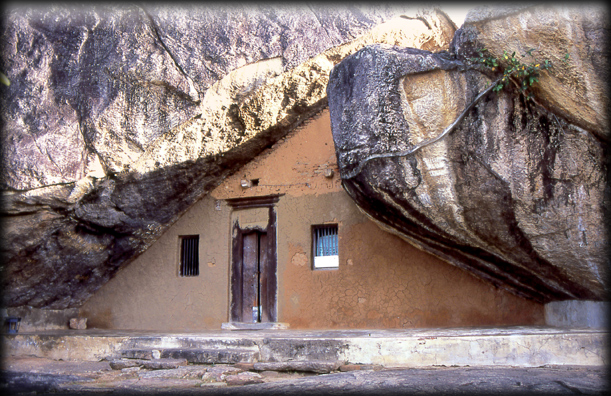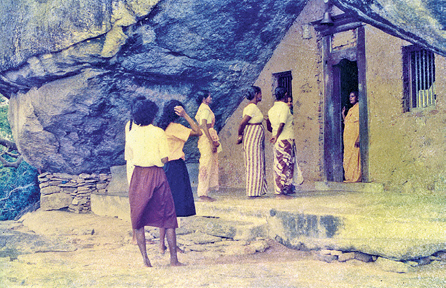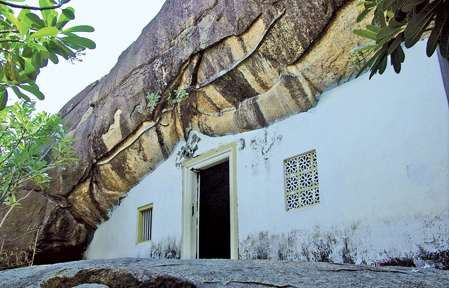|

The beautifully built main cave of Magul Maha Viharaya |
Magul Maha Viharaya at Yala:
Serenity in the wilderness
Story and pictures by Mahil Wijesinghe
The herd of spotted deer, silhouetted against the morning sun,
remained motionless as we drove down the gravel road. In the stillness
of the forest, the melodious trills of the long feathered peacocks were
distinct as were the swishing of leaves and the calls of the other
animals. It was serenity at its best.
We were a few kilometres inside the magnificent Ruhuna Wildlife
Sanctuary, heading towards a lesser known archaeological site called
Magul Maha Viharaya, with its 2nd Century BC monastery, majestic rock
boulder and stone ruins.
Five kilometres from Tissamaharama, a gravel road branches off the
main road that lead to Situlpahuwa. A half-hour drive takes you through
quaint village-scenes that progressively becomes dense jungle, and
before long you are at the foot of a huge rocky boulder, to the left of
which you find the majestic Magul Maha Viharaya. For many of those
travelling to Situlpahuwa, this is a stopover point, for breakfast,
lunch or just respite.
From here it is another half-hour drive to Situlpahuwa, another
ancient monastic site, believed to be one of the few of its kind in Sri
Lanka. Most visitors to the Kataragama sacred site detour to this place
for a brief visit.
Magul Maha Viharaya is a massive rock boulder comprising natural
water pools and numerous drip-ledged caves, scattered around several
acres in Block-1 of the Yala Wildlife sanctuary. Surrounding the Magul
Maha Viharaya, lie many ruined dagobas and monuments.
|

One of the Bhikkunis who dwelled in the main cave talking to
a group of pilgrims in 1990 |
|

The small cave with partly damaged walls used by monks to
meditate |
 |
According to folklore, Magul Maha Viharaya at Yala was built to
commemorate the marriage celebrations of Vihara Maha Devi, daughter of
Kelani Tissa to Kavan Tissa, ruler of Ruhuna. Vihara Maha Devi,
according to tradition, was set adrift on a boat by her father as a
living sacrifice to appease the remorseless sea erosion in his kingdom.
After days and nights of drifting, her boat touched at Kirinda where
soldiers found her and took her to King Kavan Tissa, who later married
her at the site of Magul Maha Viharaya. They were the parents of Princes
Duthagamini or Duttu Gemunu and Saddha Tissa. Warrior King Duttu Gemunu
vanquishing all rivals, created a unified Sri Lanka.
However, there are two contradictory legends associated with Queen
Vihara Maha Devi's drifting. Some historians say the Queen's boat had
touched at what's currently known as Arugam Bay in Pottuvil.
Contradictory legends
This is corroborated by the evidence of ancient ruins at Mudu Maha
Viharaya, close to the shore at Pottuvil. Here, legend has it that as
King Kavan Tissa married Queen Vihara Maha Devi at another ancient site
called Magul Maha Viharaya in Lahugala, 11 kilometres from Mudu Maha
Viharaya at Pottuvil. At Lahugala, we can still see among other ruins,
the ruins of a stone carved foundation purportedly of King Kavan Tissa's
nuptials.
Legends notwithstanding, Magul Maha Viharaya at Yala still tweaks the
travellers' curiosity, despite the, numerous renovations that have been
made to the original structure. In fact the Stupa on a small hillock
constructed only a few years ago.
Until recently the Magul Maha Viharaya remained inhabited, with a few
Bhikkunis dwelling in the caves of the site. The chanting of aged-old
verses could be heard from a distance, while smoke rose from the kitchen
indicating life. My memory goes back to 1990, when I first visited Magul
Maha Viharaya at Yala with my mother. We were on a pilgrimage. The main
cave of the Viharaya was triangular in shape. The front wall built with
thick bricks and had a narrow door and two small windows. The Viharaya
was occupied by saffron-clad Bhikkunis. They said they were not
disturbed by wild animals that roamed nearby, not even when wild
elephants put their trunk inside the room. However, during my recent
visit, I saw the main cave and entire site abandoned and staying
desolate. The meditating Bhikkunis had left the place a long while ago.
Centre of Buddhism
Built into a side of the rock is the recently renovated shrine room,
containing a statue of the Buddha. The drip-ledged cave of the shrine
room is believed to have been originally used by monks to meditate.
Scattered around the site are many small caves with partly damaged brick
walls that had been used by meditating monks of bygone eras. Today, the
more adventurous venturing off the little path that lead out from near
the shrine room, can find remnants of the caves and rooms.
Unlike
the rest of the sanctuary, the best way to enjoy the sights and sound of
the area surrounding the rocky boulder of Magul Maha Viharaya is to
traverse by foot instead of being cramped inside a vehicle.
Recently, a team of archaeologists of the Department of Archaeology
carried out some archaeological excavations at the site of Magul Maha
Viharaya and have found evidence that it had been a Buddhist monastery
dating back to the 2nd Century BC. They also unearthed the Bodhigaraya
(enclosure for the Bo tree) dating back to the 1st Century and remnants
of pottery.
During the Pre-Christian era, the Ruhuna Wildlife Sanctuary and its
environ had been prosperous human civilization and a centre of Buddhism
with numerous monasteries and rock caves. More than 50 inscriptions are
found within the Ruhuna Wildlife Sanctuary, most of which dates back to
the first or second century BC. There are about 40 documented
archaeological sites within the Ruhuna Wildlife Sanctuary. Thus, an
examination of historical monuments shows that Ruhuna played an
important part from very early times in the history of Buddhism. |

